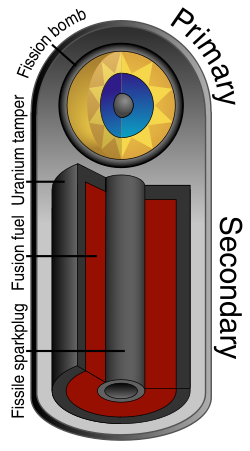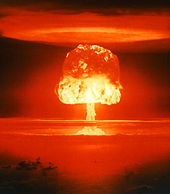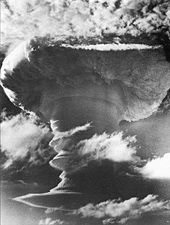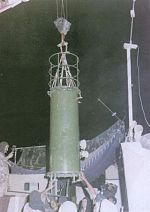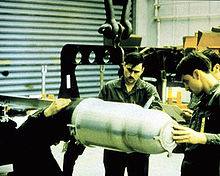- Teller–Ulam design
-
The Teller–Ulam design is the nuclear weapon design concept used in most of the world's nuclear weapons.[1] It is colloquially referred to as "the secret of the hydrogen bomb" because it employs hydrogen fusion, though in most applications the bulk of its destructive energy comes from uranium fission, not hydrogen fusion.[2] It is named for its two chief contributors, Edward Teller and Stanisław Ulam, who developed it in 1951 for the United States, with certain concepts developed with the contribution of John von Neumann. It was first used in multi-megaton-range thermonuclear weapons. As it is also the most efficient design concept for small nuclear weapons; today virtually all the nuclear weapons deployed by the five major nuclear-armed nations use the Teller–Ulam design.[3]
Its essential features, which officially remained secret for nearly three decades, are: 1) separation of stages into a triggering "primary" explosive and a much more powerful "secondary" explosive, 2) compression of the secondary by X-rays coming from nuclear fission in the primary, a process called the "radiation implosion" of the secondary, and 3) heating of the secondary, after cold compression, by a second fission explosion inside the secondary.
The radiation implosion mechanism is a heat engine exploiting the temperature difference between the secondary's hot, surrounding radiation channel and its relatively cool interior. This temperature difference is briefly maintained by a massive heat barrier called the "pusher", which also serves as an implosion tamper, increasing and prolonging the compression of the secondary. If made of uranium—and it usually is—it can capture neutrons produced by the fusion reaction and undergo fission itself, increasing the overall explosive yield. In many Teller–Ulam weapons, fission of the pusher dominates the explosion and produces radioactive fission product fallout.
The first test of this principle was the "Ivy Mike" nuclear test in 1952, conducted by the United States. In the Soviet Union, the design was known as Andrei Sakharov's "Third Idea", first tested in 1955. Similar devices were developed by the United Kingdom, China, and France, though no specific code names are known for their designs.
Contents
Public knowledge concerning nuclear weapon design
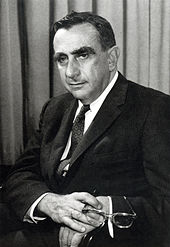 Edward Teller in 1958
Edward Teller in 1958
Detailed knowledge of fission and fusion weapons is classified to some degree in virtually every industrialized nation. In the United States, such "knowledge" can by default be classified as Restricted Data, even if it is created by persons who are not government employees or associated with weapons programs, in a legal doctrine known as "born secret" (though the constitutional standing of the doctrine has been at times called into question, see United States v. The Progressive). Born secret is rarely invoked for cases of private speculation. The official policy of the United States Department of Energy has been not to acknowledge the leaking of design information, as such acknowledgment would potentially validate the information as accurate. In a small number of prior cases, the U.S. government has attempted to censor weapons information in the public press, with limited success.
Though large quantities of vague data have been officially released, and larger quantities of vague data have been unofficially leaked by former bomb designers, most public descriptions of nuclear weapon design details rely to some degree on speculation, reverse engineering from known information, or comparison with similar fields of physics (inertial confinement fusion is the primary example). Such processes have resulted in a body of unclassified knowledge about nuclear bombs which is generally consistent with official unclassified information releases, related physics, and is thought to be internally consistent, though there are some points of interpretation which are still considered open. The state of public knowledge about the Teller–Ulam design has been mostly shaped from a few specific incidents outlined in a section below.
Basic principle
The basic principle of the Teller–Ulam configuration is the idea that different parts of a thermonuclear weapon can be chained together in "stages", with the detonation of each stage providing the energy to ignite the next stage. At a bare minimum, this implies a primary section which consists of a fission bomb (a "trigger"), and a secondary section which consists of fusion fuel. The energy released by the primary compresses the secondary through a process called "radiation implosion", at which point it is heated and undergoes nuclear fusion. Because of the staged design, it is thought that a tertiary section, again of fusion fuel, could be added as well, based on the same principle as the secondary; the AN602 "Tsar Bomba" is thought to have been a three-stage device.
Surrounding the other components is a hohlraum or radiation case, a container which traps the first stage or primary's energy inside temporarily. The outside of this radiation case, which is also normally the outside casing of the bomb, is the only direct visual evidence publicly available of any thermonuclear bomb component's configuration. Numerous photographs of various thermonuclear bomb exteriors have been declassified.[4]
The primary is thought to be a standard implosion method fission bomb, though likely with a core boosted by small amounts of fusion fuel (usually 50/50% deuterium/tritium gas) for extra efficiency; the fusion fuel releases excess neutrons when heated and compressed, inducing additional fission. Generally, a research program with the capacity to create a thermonuclear bomb has already mastered the ability to engineer boosted fission. When fired, the plutonium-239 (Pu-239) and/or uranium-235 (U-235) core would be compressed to a smaller sphere by special layers of conventional high explosives arranged around it in an explosive lens pattern, initiating the nuclear chain reaction that powers the conventional "atomic bomb".
The secondary is usually shown as a column of fusion fuel and other components wrapped in many layers. Around the column is first a "pusher-tamper", a heavy layer of uranium-238 (U-238) or lead which serves to help compress the fusion fuel (and, in the case of uranium, may eventually undergo fission itself). Inside this is the fusion fuel itself, usually a form of lithium deuteride, which is used because it is easier to weaponize than liquified tritium/deuterium gas (compare the success of the cryogenic deuterium-based Ivy Mike experiment to the (over)success of the lithium deuteride-based Castle Bravo experiment). This dry fuel, when bombarded by neutrons, produces tritium, a heavy isotope of hydrogen which can undergo nuclear fusion, along with the deuterium present in the mixture. (See the article on nuclear fusion for a more detailed technical discussion of fusion reactions.) Inside the layer of fuel is the "spark plug", a hollow column of fissile material (plutonium-239 or uranium-235) which, when compressed, can itself undergo nuclear fission (because of the shape, it is not a critical mass without compression). The tertiary, if one is present, would be set below the secondary and probably be made up of the same materials.[5][6]
Separating the secondary from the primary is the interstage. The fissioning primary produces four types of energy: 1) expanding hot gases from high explosive charges which implode the primary; 2) superheated plasma that was originally the bomb's fissile material and its tamper; 3) the electromagnetic radiation; and 4) the neutrons from the primary's nuclear detonation. The interstage is responsible for accurately modulating the transfer of energy from the primary to the secondary. It must direct the hot gases, plasma, electromagnetic radiation and neutrons toward the right place at the right time. Less than optimal interstage designs have resulted in the secondary failing to work entirely on multiple shots, known as a "fissile fizzle". The Koon shot of Operation Castle is a good example; a small flaw allowed the neutron flux from the primary to prematurely begin heating the secondary, weakening the compression enough to prevent any fusion.
There is very little detailed information in the open literature about the mechanism of the interstage. One of the best sources is a simplified diagram of a British thermonuclear weapon similar to the American W76 warhead. It was released by Greenpeace in a report titled "Dual Use Nuclear Technology".[7] The major components and their arrangement are in the diagram, though details are almost absent; what scattered details it does include likely have intentional omissions and/or inaccuracies. They are labeled "End-cap and Neutron Focus Lens" and "Reflector Wrap"; the former channels neutrons to the U-235/Pu-239 Spark Plug while the latter refers to an X-ray reflector; typically a cylinder made out of an X-ray opaque material such as uranium with the primary and secondary at either end. It does not reflect like a mirror; instead, it gets heated to a high temperature by the X-ray flux from the primary, then it emits more evenly spread X-rays which travel to the secondary, causing what is known as radiation implosion. Next comes the "Reflector/Neutron Gun Carriage". The reflector seals the gap between the Neutron Focus Lens (in the center) and the outer casing near the primary. It separates the primary from the secondary and performs the same function as the previous reflector. There are about six neutron guns (seen here from Sandia National Laboratories [8]) each poking through the outer edge of the reflector with one end in each section; all are clamped to the carriage and arranged more or less evenly around the casing's circumference. The neutron guns are tilted so the neutron emitting end of each gun end is pointed towards the central axis of the bomb. Neutrons from each neutron gun pass through and are focussed by the neutron focus lens towards the centre of primary in order to boost the initial fissioning of the plutonium. A "Polystyrene Polarizer/Plasma Source" is also shown (see below).
The first U.S. government document to mention the interstage was only recently released to the public promoting the 2004 initiation of the Reliable Replacement Warhead Program. A graphic includes blurbs describing the potential advantage of a RRW on a part by part level, with the interstage blurb saying a new design would replace "toxic, brittle material" and "expensive 'special' material... [which require] unique facilities".[9] The "toxic, brittle material" is widely assumed to be beryllium, which fits that description and would also moderate the neutron flux from the primary. Some material to absorb and re-radiate the X-rays in a particular manner may also be used.[10]
The "special material" is thought to be a substance called "FOGBANK", an unclassified codename, though it is often referred to as "THE fogbank" (or "A Fogbank") as if it were a subassembly instead of a material. Its composition is classified, though aerogel has been suggested as a possibility. Manufacture stopped for many years; however, the Life Extension Program required it to start up again – Y-12 currently being the sole producer (the "unique facility" referenced). Manufacture involves the moderately toxic and moderately volatile solvent called acetonitrile, which presents a hazard for workers (causing three evacuations in March 2006 alone).[11]
Summary
A simplified summary of the above explanation would be:
- An implosion assembly type of fission bomb is exploded. This is the primary stage. If a small amount of deuterium/tritium gas is placed inside the primary's core, it will be compressed during the explosion and a nuclear fusion reaction will occur; the released neutrons from this fusion reaction will induce further fission in the plutonium-239 or uranium-235 used in the primary stage. The use of fusion fuel to enhance the efficiency of a fission reaction is called boosting. Without boosting, a large portion of the fissile material will remain unreacted; the Little Boy and Fat Man bombs had an efficiency of only 1.4% and 17%, respectively, because they were unboosted.
- Energy released in the primary stage is transferred to the secondary (or fusion) stage. The exact mechanism whereby this happens is unknown. This energy compresses the fusion fuel and sparkplug; the compressed sparkplug becomes critical and undergoes a fission chain reaction, further heating the compressed fusion fuel to a high enough temperature to induce fusion, and also supplying neutrons that react with lithium to create tritium for fusion. Generally, increasing the kinetic energy of gas molecules contained in a limited volume will increase both temperature and pressure (see gas laws).
- The fusion fuel of the secondary stage may be surrounded by depleted uranium or natural uranium, whose U-238 is not fissile and cannot sustain a chain reaction, but which is fissionable when bombarded by the high-energy neutrons released by fusion in the secondary stage.
Thermonuclear weapons may or may not use a boosted primary stage, use different types of fusion fuel, and may surround the fusion fuel with beryllium (or another neutron reflecting material) instead of depleted uranium to prevent further fission from occurring.
The remaining secret: how the secondary is compressed
The basic idea of the Teller–Ulam configuration is that each "stage" would undergo fission or fusion (or both) and release energy, much of which would be transferred to another stage to trigger it. How exactly the energy is "transported" from the primary to the secondary has been the subject of some disagreement in the open press, but is thought to be transmitted through the X-rays which are emitted from the fissioning primary. This energy is then used to compress the secondary. The crucial detail of how the X-rays create the pressure is the main remaining disputed point in the unclassified press. There are five proposed theories:
- Neutron pressure from the primary explosion. This was allegedly Ulam's first concept and was abandoned as unworkable.
- Blast wave from the primary explosion. This was allegedly Ulam's second concept and was abandoned as unworkable.
- Radiation pressure exerted by the X-rays. This was the first idea put forth by Howard Morland in the article in The Progressive.
- X-rays creating a plasma in the radiation case's filler (a polystyrene or "FOGBANK" plastic foam). This was a second idea put forward by Chuck Hansen and later by Howard Morland.
- Tamper/Pusher ablation.
Radiation pressure
The radiation pressure exerted by the large quantity of X-ray photons inside the closed casing might be enough to compress the secondary. For two thermonuclear bombs for which the general size and primary characteristics are well understood, the Ivy Mike test bomb and the modern W-80 cruise missile warhead variant of the W-61 design, the radiation pressure was calculated to be 73 million bar (atmospheres) (7.3 T Pa) for the Ivy Mike design and 1,400 million bar (140 TPa) for the W-80.[12]
Foam plasma pressure
Foam plasma pressure is the concept which Chuck Hansen introduced during the Progressive case, based on research which located declassified documents listing special foams as liner components within the radiation case of thermonuclear weapons.
The sequence of firing the weapon (with the foam) would be as follows:
- The high explosives surrounding the core of the primary fire, compressing the fissile material into a supercritical state and beginning the fission chain reaction.
- The fissioning primary emits X-rays, which "reflect" along the inside of the casing, irradiating the polystyrene foam.
- The irradiated foam undergoes a phase transition, becoming a hot plasma, pushing against the tamper of the secondary, compressing it tightly, and beginning the fission reaction in the spark plug.
- Pushed from both sides (from the primary and the spark plug), the lithium deuteride fuel is highly compressed and heated to thermonuclear temperatures. Also, by being bombarded with neutrons, each lithium-6 atom splits into one tritium atom and one alpha particle. Then begins a fusion reaction between the tritium and the deuterium, releasing even more neutrons, and a huge amount of energy.
- The fuel undergoing the fusion reaction emits a large flux of neutrons, which irradiates the U-238 tamper (or the U-238 bomb casing), causing it to undergo a fission reaction, providing about half of the total energy.
This would complete the fission-fusion-fission sequence. Fusion, unlike fission, is relatively "clean"—it releases energy but no harmful radioactive products or large amounts of nuclear fallout. The fission reactions though, especially the last fission reaction, release a tremendous amount of fission products and fallout. If the last fission stage is omitted, by replacing the uranium tamper with one made of lead, for example, the overall explosive force is reduced by approximately half but the amount of fallout is relatively low. The neutron bomb is a hydrogen bomb without the final fission stage.
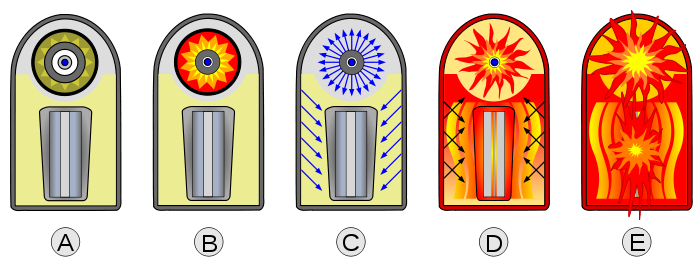 Foam plasma mechanism firing sequence.
Foam plasma mechanism firing sequence.
- Warhead before firing; primary (fission bomb) at top, secondary (fusion fuel) at bottom, all suspended in polystyrene foam.
- High-explosive fires in primary, compressing plutonium core into supercriticality and beginning a fission reaction.
- Fission primary emits X-rays which are scattered along the inside of the casing, irradiating the polystyrene foam.
- Polystyrene foam becomes plasma, compressing secondary, and plutonium sparkplug begins to fission.
- Compressed and heated, lithium-6 deuteride fuel produces tritium and begins the fusion reaction. The neutron flux produced causes the U-238 tamper to fission. A fireball starts to form.
Current technical criticisms of the idea of "foam plasma pressure" focus on unclassified analysis from similar high energy physics fields which indicate that the pressure produced by such a plasma would only be a small multiplier of the basic photon pressure within the radiation case, and also that the known foam materials intrinsically have a very low absorption efficiency of the gamma ray and X-ray radiation from the primary. Most of the energy produced would be absorbed by either the walls of the radiation case and/or the tamper around the secondary. Analyzing the effects of that absorbed energy led to the third mechanism: ablation.
Tamper-pusher ablation
The tamper-pusher ablation proposed mechanism is that the primary compression mechanism for the thermonuclear secondary is that the outer layers of the tamper-pusher, or heavy metal casing around the thermonuclear fuel, are heated so much by the X-ray flux from the primary that they ablate away, exploding outwards at such high speed that the rest of the tamper recoils inwards at a tremendous velocity, crushing the fusion fuel and the spark plug.
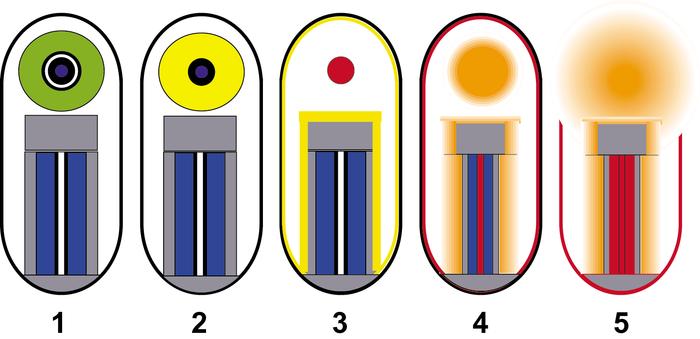 Ablation mechanism firing sequence.
Ablation mechanism firing sequence.
- Warhead before firing. The nested spheres at the top are the fission primary; the cylinders below are the fusion secondary device.
- Fission primary's explosives have detonated and collapsed the primary's fissile pit.
- The primary's fission reaction has run to completion, and the primary is now at several million degrees and radiating gamma and hard X-rays, heating up the inside of the hohlraum and the shield and secondary's tamper.
- The primary's reaction is over and it has expanded. The surface of the pusher for the secondary is now so hot that it is also ablating or expanding away, pushing the rest of the secondary (tamper, fusion fuel, and fissile spark plug) inwards. The spark plug starts to fission. Not depicted: the radiation case is also ablating and expanding outwards (omitted for clarity of diagram).
- The secondary's fuel has started the fusion reaction and shortly will burn up. A fireball starts to form.
Rough calculations for the basic ablation effect are relatively simple: the energy from the primary is distributed evenly onto all of the surfaces within the outer radiation case, with the components coming to a thermal equilibrium, and the effects of that thermal energy are then analyzed. The energy is mostly deposited within about one X-ray optical thickness of the tamper/pusher outer surface, and the temperature of that layer can then be calculated. The velocity at which the surface then expands outwards is calculated and, from a basic Newtonian momentum balance, the velocity at which the rest of the tamper implodes inwards.
Applying the more detailed form of those calculations to the Ivy Mike device yields vaporized pusher gas expansion velocity of 290 kilometers per second and an implosion velocity of perhaps 400 kilometers per second if 3/4 of the total tamper/pusher mass is ablated off, the most energy efficient proportion. For the W-80 the gas expansion velocity is roughly 410 kilometers per second and the implosion velocity 570 kilometers per second. The pressure due to the ablating material is calculated to be 5.3 billion bar (530 T Pa) in the Ivy Mike device and 64 billion bar (6.4 P Pa) in the W-80 device.[12]
Comparing the implosion mechanisms
Comparing the three mechanisms proposed, it can be seen that:
Mechanism Pressure (TPa) Ivy Mike W80 radiation pressure 7.3 140 plasma pressure 35 750 ablation pressure 530 6400 The calculated ablation pressure is one order of magnitude greater than the higher proposed plasma pressures and nearly two orders of magnitude greater than calculated radiation pressure. No mechanism to avoid the absorption of energy into the radiation case wall and the secondary tamper has been suggested, making ablation apparently unavoidable. The other mechanisms appear to be unneeded.
United States Department of Defense official declassification reports indicate that foamed plastic materials are or may be used in radiation case liners, and despite the low direct plasma pressure they may be of use in delaying the ablation until energy has distributed evenly and a sufficient fraction has reached the secondary's tamper/pusher.[13]
Richard Rhodes' book Dark Sun stated that a 1-inch-thick (25 mm) layer of plastic foam was fixed to the lead liner of the inside of the Ivy Mike steel casing using copper nails. Rhodes quotes several designers of that bomb explaining that the plastic foam layer inside the outer case is to delay ablation and thus recoil of the outer case: if the foam were not there, metal would ablate from the inside of the outer case with a large impulse, causing the casing to recoil outwards rapidly. The purpose of the casing is to contain the explosion for as long as possible, allowing as much X-ray ablation of the metallic surface of the secondary stage as possible, so it compresses the secondary efficiently, maximizing the fusion yield. Plastic foam has a low density, so causes a smaller impulse when it ablates than metal does.[13]
Design variations
A number of possible variations to the weapon design have been proposed:
- Either the tamper or the casing have been proposed as being made of uranium-238 for the final fission stage.
- In some descriptions, additional internal structures exist to protect the secondary from receiving excessive neutrons from the primary.
- The inside of the casing may or may not be specially machined to "reflect" the X-rays. X-ray "reflection" is not like light reflecting off of a mirror, but rather the reflector material is heated by the X-rays, causing the material itself to emit X-rays, which then travel to the secondary.
Two special variations exist which will be discussed in a further section: the cryogenically cooled liquid deuterium device used for the Ivy Mike test, and the putative design of the W88 nuclear warhead — a small, MIRVed version of the Teller–Ulam configuration with a prolate (egg or watermelon shaped) primary and an elliptical secondary. Most bombs do not apparently have tertiary stages — the U.S. is only thought to have produced one such model, the heavy but highly efficient (i.e., nuclear weapon yield per unit bomb weight) 25 Mt B41 nuclear bomb,[14] and the Soviet Union is thought to have used multiple stages in their 50 megaton (100 Mt in use) Tsar Bomba. If any hydrogen bombs have been made from configurations other than those based on the Teller–Ulam design, the fact of it is not publicly known, with the possible exception of the Soviet early Sloika design.
In essence, the Teller–Ulam configuration relies on at least two instances of implosion occurring: first, the conventional (chemical) explosives in the primary would compress the fissile core, resulting in a fission explosion many times more powerful than that which chemical explosives could achieve alone. Second, the radiation from the fissioning of the primary would be used to compress and ignite the secondary, resulting in a fusion explosion many times more powerful than the fission explosion alone. This chain of compression could then be continued with an arbitrary number of secondaries, and would end with the fissioning of the natural uranium tamper, something which could not normally be achieved without the neutron flux provided by the fusion reactions in the secondary. Such a design can be scaled up to an arbitrary strength, potentially to the level of a "doomsday device", but usually such weapons are not more than a dozen megatons, which is generally considered enough to destroy even the largest practical targets.
History
Main article: History of the Teller–Ulam designAmerican developments
The idea of a thermonuclear fusion bomb ignited by a smaller fission bomb was first proposed by Enrico Fermi to his colleague Edward Teller in 1941 at the start of what would become the Manhattan Project. Teller spent most of the Manhattan Project attempting to figure out how to make the design work, to some degree neglecting his assigned work on the Manhattan Project fission bomb program. His difficult and devil's advocate attitude in discussions led Oppenheimer to sidetrack him and other "problem" physicists into the super program to smooth his way.
Stanislaw Ulam, a coworker of Teller's, made the first key conceptual leaps towards a workable fusion design. Ulam's two innovations which rendered the fusion bomb practical were that compression of the thermonuclear fuel before extreme heating was a practical path towards the conditions needed for fusion, and the idea of staging or placing a separate thermonuclear component outside a fission primary component, and somehow using the primary to compress the secondary. Teller then realized that the gamma and X-ray radiation produced in the primary could transfer enough energy into the secondary to create a successful implosion and fusion burn, if the whole assembly was wrapped in a hohlraum or radiation case. Teller and his various proponents and detractors later disputed the degree to which Ulam had contributed to the theories underlying this mechanism. Indeed, shortly before his death, and in a last-ditch effort to discredit Ulam's contributions, Teller claimed that one of his own "graduate students" had proposed the mechanism.
The "George" shot of Operation Greenhouse in 1951 tested the basic concept for the first time on a very small scale, raising expectations to a near certainty that the concept would work.
On November 1, 1952, the Teller–Ulam configuration was tested at full scale in the "Ivy Mike" shot at an island in the Enewetak Atoll, with a yield of 10.4 megatons (over 450 times more powerful than the bomb dropped on Nagasaki during World War II). The device, dubbed the Sausage, used an extra-large fission bomb as a "trigger" and liquid deuterium—kept in its liquid state by 20 short tons (18 metric tons) of cryogenic equipment—as its fusion fuel, and weighed around 80 short tons (70 metric tons) altogether.
The liquid deuterium fuel of Ivy Mike was impractical for a deployable weapon, and the next advance was to use a solid lithium deuteride fusion fuel instead. In 1954 this was tested in the "Castle Bravo" shot (the device was code-named the Shrimp), which had a yield of 15 megatons (2.5 times higher than expected) and is the largest U.S. bomb ever tested.
Efforts in the United States soon shifted towards developing miniaturized Teller–Ulam weapons which could easily outfit intercontinental ballistic missiles and submarine-launched ballistic missiles. By 1960, with the W47 warhead[15] deployed on Polaris ballistic missile submarines, megaton-class warheads were as small as 18 inches (0.5 m) in diameter and 720 pounds (320 kg) in weight. It was later found in live testing that the Polaris warhead did not work reliably and had to be redesigned. Further innovation in miniaturizing warheads was accomplished by the mid-1970s, when versions of the Teller–Ulam design were created which could fit ten or more warheads on the end of a small MIRVed missile (see the section on the W88 below).[4]
Soviet developments
See also: Soviet atomic bomb project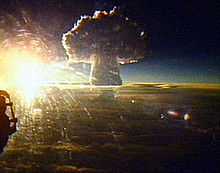 Mushroom cloud from the Soviet 50-megaton Tsar Bomba, the largest weapon ever detonated (1961)
Mushroom cloud from the Soviet 50-megaton Tsar Bomba, the largest weapon ever detonated (1961)
The first Soviet fusion design, developed by Andrei Sakharov and Vitaly Ginzburg in 1949 (before the Soviets had a working fission bomb), was dubbed the Sloika, after a Russian layer cake, and was not of the Teller–Ulam configuration. It used alternating layers of fissile material and lithium deuteride fusion fuel spiked with tritium (this was later dubbed Sakharov's "First Idea"). Though nuclear fusion might have been technically achievable, it did not have the scaling property of a "staged" weapon. Thus, such a design could not produce thermonuclear weapons whose explosive yields could be made arbitrarily large (unlike U.S. designs at that time). The fusion layer wrapped around the fission core could only moderately multiply the fission energy (modern Teller–Ulam designs can multiply it 30-fold). Additionally, the whole fusion stage had to be imploded by conventional explosives, along with the fission core, multiplying the bulk of chemical explosives needed substantially.
Their first Sloika design test, Joe 4, was detonated in 1953 with a yield equivalent to 400 kilotons of TNT (15%–20% from fusion). Attempts to use a Sloika design to achieve megaton-range results proved unfeasible. After the U.S. tested the "Ivy Mike" bomb in November 1952, proving that a multimegaton bomb could be created, the Soviets searched for an additional design. The "Second Idea", as Sakharov referred to it in his memoirs, was a previous proposal by Ginzburg in November 1948 to use lithium deuteride in the bomb, which would, in the course of being bombarded by neutrons, produce tritium and free deuterium.[16] In late 1953 physicist Viktor Davidenko achieved the first breakthrough, that of keeping the primary and secondary parts of the bombs in separate pieces ("staging"). The next breakthrough was discovered and developed by Sakharov and Yakov Zel'dovich, that of using the X-rays from the fission bomb to compress the secondary before fusion ("radiation implosion"), in early 1954. Sakharov's "Third Idea", as the Teller–Ulam design was known in the USSR, was tested in the shot "RDS-37" in November 1955 with a yield of 1.6 megatons.
The Soviets demonstrated the power of the "staging" concept in October 1961, when they detonated the massive and unwieldy Tsar Bomba, a 50 megaton hydrogen bomb that derived almost 97% of its energy from fusion. It was the largest nuclear weapon developed and tested by any country, but was far too large for military purpose to use as a weapon – even though it was dropped from an airplane in its lone test over Novaya Zemlya.
British developments
In 1954 work began at Aldermaston to develop the British fusion bomb, with Sir William Penney in charge of the project. British knowledge on how to make a thermonuclear fusion bomb was rudimentary, and at the time the United States was not exchanging any nuclear knowledge because of the Atomic Energy Act of 1946. However, the British were allowed to observe the American Castle tests and used sampling aircraft in the mushroom clouds, providing them with clear, direct evidence of the compression produced in the secondary stages by radiation implosion.
Because of these difficulties, in 1955 British prime minister Anthony Eden agreed to a secret plan, whereby if the Aldermaston scientists failed or were greatly delayed in developing the fusion bomb, it would be replaced by an extremely large fission bomb.
In 1957 the Operation Grapple tests were carried out. The first test, Green Granite was a prototype fusion bomb, but failed to produce equivalent yields compared to the Americans and Soviets, only achieving approximately 300 kilotons. The second test Orange Herald was the modified fission bomb and produced 700 kilotons—making it the largest fission explosion ever. At the time almost everyone (including the pilots of the plane that dropped it) thought that this was a fusion bomb. This bomb was put into service in 1958. A second prototype fusion bomb Purple Granite was used in the third test, but only produced approximately 150 kilotons.
A second set of tests was scheduled, with testing recommencing in September 1957. The first test was based on a "… new simpler design. A two stage thermonuclear bomb which had a much more powerful trigger". This test Grapple X Round C was exploded on November 8 and yielded approximately 1.8 megatons. On April 28, 1958 a bomb was dropped that yielded 3 megatons—Britain's most powerful test. Two final air burst tests on September 2 and September 11, 1958, dropped smaller bombs that yielded around 1 megaton each.
American observers had been invited to these kinds of tests. After their successful detonation of a megaton-range device (and thus demonstrating their practical understanding of the Teller–Ulam design "secret"), the United States agreed to exchange some of their nuclear designs with the United Kingdom, leading to the 1958 US–UK Mutual Defence Agreement. Instead of continuing with their own design, the British were given access to the design of the smaller American Mk 28 warhead and were able to manufacture copies.
Chinese developments
The People's Republic of China detonated its first device using a Teller–Ulam design June 17, 1967 ("Test No. 6"), a mere 32 months after detonating its first fission weapon (the shortest fission-to-fusion development in history), with a yield of 3.31 Mt.
French developments
Very little is known about the French development of the Teller–Ulam design beyond the fact that they detonated a 2.6 Mt device in the "Canopus" test in August 1968.
Other countries
Israel
Main article: Israel and weapons of mass destructionIsrael is alleged to possess thermonuclear weapons of the Teller–Ulam design, but is not known to have tested any nuclear devices.
India
Main article: India and weapons of mass destructionIndia's first nuclear test occurred on May 18, 1974, which initially surprised the world. The first test, codename Smiling Buddha, was not a thermonuclear device according to the Bhabha Atomic Research Centre.[17] On May 11, 1998, India reportedly detonated a thermonuclear bomb in its Operation Shakti tests ("Shakti-1", specifically).[17] Dr. Samar Mubarakmand asserted that Shakti-1 was a successful test, but if it was a thermonuclear device as claimed, then it failed to produce certain results that were to be expected of a thermonuclear device.[17]
Director for the 1998 test site preparations, Dr. K. Santhanam, reported the yield of thermonuclear explosion was lower than expected, although his statement has been disputed by other Indian scientists involved in the test.[18] Indian sources, using local data and citing a US Geologic Survey report compiling seismic data from 125 IRIS stations across the world, argue that the magnitudes suggested a combined yield of up to 60 kilotonnes, consistent with the Indian announced total yield of 56 kilotonnes [19][20] However, several independent experts have reported lower yields for the nuclear test and remained skeptical about the claims,[17] and others have argued that even the claimed 50 kiloton yield was low for confirmation of a thermonuclear design.[21][17]
Pakistan
Main article: Pakistan and weapons of mass destructionAccording to the scientific data received and published by PAEC, the Corps of Engineers, and Kahuta Research Laboratories (KRL), in May 1998, Pakistan carried out 6 underground nuclear tests in Chagai Hills and Kharan Desert in Balochistan Province (See the code-names of the tests, Chagai-I and Chagai-II).[17] None of these boosted fission devices were the thermonuclear weapon design, according to KRL and PAEC.[17]
North Korea
Main article: North Korea and weapons of mass destructionNorth Korea's two nuclear tests (2006 and 2009) were relatively low yield and do not appear to have been of a thermonuclear weapon design.
Public knowledge
The Teller–Ulam design was for many years considered one of the top nuclear secrets, and even today it is not discussed in any detail by official publications with origins "behind the fence" of classification. United States Department of Energy (DOE) policy has been, and continues to be, that they do not acknowledge when "leaks" occur, because doing so would acknowledge the accuracy of the supposed leaked information.
Aside from images of the warhead casing, most information in the public domain about this design is regulated to a few terse statements by the DOE and the work of a few individual investigators.
DOE statements
In 1972 the United States government declassified a statement that "The fact that in thermonuclear (TN) weapons, a fission 'primary' is used to trigger a TN reaction in thermonuclear fuel referred to as a 'secondary'", and in 1979 added, "The fact that, in thermonuclear weapons, radiation from a fission explosive can be contained and used to transfer energy to compress and ignite a physically separate component containing thermonuclear fuel." To this latter sentence they specified that "Any elaboration of this statement will be classified."[22] The only statement which may pertain to the spark plug was declassified in 1991: "Fact that fissile and/or fissionable materials are present in some secondaries, material unidentified, location unspecified, use unspecified, and weapons undesignated." In 1998 the DOE declassified the statement that "The fact that materials may be present in channels and the term 'channel filler,' with no elaboration", which may refer to the polystyrene foam (or an analogous substance).[23]
Whether these statements vindicate some or all of the models presented above is up for interpretation, and official U.S. government releases about the technical details of nuclear weapons have been purposely equivocating in the past (see, e.g., Smyth Report). Other information, such as the types of fuel used in some of the early weapons, has been declassified, though of course precise technical information has not been.
The Progressive case
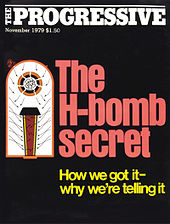 Most of what is known to the public today about the Teller–Ulam design comes from a 1979 magazine article. This edition is available online.
Most of what is known to the public today about the Teller–Ulam design comes from a 1979 magazine article. This edition is available online.
Most of the current ideas on the workings of the Teller–Ulam design came into public awareness after the Department of Energy (DOE) attempted to censor a magazine article by U.S. antiweapons activist Howard Morland in 1979 on the "secret of the hydrogen bomb". In 1978, Morland had decided that discovering and exposing this "last remaining secret" would focus attention onto the arms race and allow citizens to feel empowered to question official statements on the importance of nuclear weapons and nuclear secrecy. Most of Morland's ideas about how the weapon worked were compiled from highly accessible sources—the drawings which most inspired his approach came from none other than the Encyclopedia Americana. Morland also interviewed (often informally) many former Los Alamos scientists (including Teller and Ulam, though neither gave him any useful information), and used a variety of interpersonal strategies to encourage informational responses from them (i.e., asking questions such as "Do they still use spark plugs?" even if he was not aware what the latter term specifically referred to).[24]
Morland eventually concluded that the "secret" was that the primary and secondary were kept separate and that radiation pressure from the primary compressed the secondary before igniting it. When an early draft of the article, to be published in The Progressive magazine, was sent to the DOE after falling into the hands of a professor who was opposed to Morland's goal, the DOE requested that the article not be published, and pressed for a temporary injunction. The DOE argued that Morland's information was (1) likely derived from classified sources, (2) if not derived from classified sources, itself counted as "secret" information under the "born secret" clause of the 1954 Atomic Energy Act, and (3) was dangerous and would encourage nuclear proliferation.
Morland and his lawyers disagreed on all points, but the injunction was granted, as the judge in the case felt that it was safer to grant the injunction and allow Morland, et al., to appeal, which they did in United States v. The Progressive (1979).
Through a variety of more complicated circumstances, the DOE case began to wane as it became clear that some of the data they were attempting to claim as "secret" had been published in a students' encyclopedia a few years earlier. After another H-bomb speculator, Chuck Hansen, had his own ideas about the "secret" (quite different from Morland's) published in a Wisconsin newspaper, the DOE claimed that The Progressive case was moot, dropped its suit, and allowed the magazine to publish its article, which it did in November 1979. Morland had by then, however, changed his opinion of how the bomb worked, suggesting that a foam medium (the polystyrene) rather than radiation pressure was used to compress the secondary, and that in the secondary there was a spark plug of fissile material as well. He published these changes, based in part on the proceedings of the appeals trial, as a short erratum in The Progressive a month later.[25] In 1981, Morland published a book about his experience, describing in detail the train of thought which led him to his conclusions about the "secret".[24][26]
Morland's work is interpreted as being at least partially correct because the DOE had sought to censor it, one of the few times they violated their usual approach of not acknowledging "secret" material which had been released; however, to what degree it lacks information, or has incorrect information, is not known with any confidence. The difficulty that a number of nations had in developing the Teller–Ulam design (even when they apparently understood the design, such as with the United Kingdom), makes it somewhat unlikely that this simple information alone is what provides the ability to manufacture thermonuclear weapons. Nevertheless, the ideas put forward by Morland in 1979 have been the basis for all the current speculation on the Teller–Ulam design.
Variations
There have been a few variations of the Teller–Ulam design suggested by sources claiming to have information from inside of the fence of classification. Whether these are simply different versions of the Teller–Ulam design, or should be understood as contradicting the above descriptions, is up for interpretation.
Richard Rhodes' "Ivy Mike" device in Dark Sun
In his 1995 book Dark Sun: The Making of the Hydrogen Bomb, author Richard Rhodes describes in detail the internal components of the "Ivy Mike" Sausage device, based on information obtained from extensive interviews with the scientists and engineers who assembled it. According to Rhodes, though there was polystyrene in the "Mike" device, it was not used as a plasma source — the radiation from the primary itself was enough to compress the secondary. Whether or not this would apply only to the "Mike" device, or the Teller–Ulam design in general, is not known, and potentially casts some doubt onto the role of the foam, and to the exact mechanism of radiation "transport".[27]
W88 revelations
 In the W88 warhead, the primary (top) and secondary (bottom) have switched positions, to allow the secondary to be larger than in the otherwise similar W87.
In the W88 warhead, the primary (top) and secondary (bottom) have switched positions, to allow the secondary to be larger than in the otherwise similar W87.
 In the W87 warhead, the heavier secondary (top) is placed forward of the lighter primary (bottom) to promote aerodynamic stability during reentry.
In the W87 warhead, the heavier secondary (top) is placed forward of the lighter primary (bottom) to promote aerodynamic stability during reentry.
In 1999 a reporter for the San Jose Mercury News reported that the U.S. W88 nuclear warhead, a small MIRVed warhead used on the Trident II SLBM, had a prolate (egg or watermelon shaped) primary (code-named Komodo) and a spherical secondary (code-named Cursa) inside a specially shaped radiation case (known as the "peanut" for its shape).[28] A story four months later in The New York Times by William Broad[29] reported that in 1995, a supposed double agent from the People's Republic of China delivered information indicating that China knew these details about the W88 warhead, supposedly through espionage.[30] (This line of investigation eventually resulted in the abortive trial of Wen Ho Lee.) If these stories are true, it would explain the reported higher yield of the W88, 475 kilotons, compared with only 300 kilotons for the earlier W87 warhead.
The reentry cones for the two warheads are the same size, 1.75 meters (69 in) long, with a maximum diameter of 55 cm. (22 in).[31] The higher yield of the W88 implies a larger secondary, which produces most of the yield. Putting the secondary, which is heavier than the primary, in the wider part of the cone allows it to be larger, but it also moves the center of mass aft, potentially causing aerodynamic stability problems during reentry. Dead-weight ballast must be added to the nose to move the center of mass forward.
To make the primary small enough to fit into the narrow part of the cone, its bulky insensitive high explosive charges must be replaced with more compact "non-insensitive" high explosives which are more hazardous to handle. The higher yield of the W88, which is the last new warhead produced by the United States, thus comes at a price of higher warhead weight and higher workplace hazard.[32]
References
Bibliography
- Basic principles
- "Engineering and Design of Nuclear Weapons" from Carey Sublette's Nuclear Weapons FAQ.
- Chuck Hansen, U.S. nuclear weapons: The secret history (Arlington, TX: Aerofax, 1988). ISBN 0-517-56740-7
- Chuck Hansen, The Swords of Armageddon: U.S. nuclear weapons development since 1945 (Sunnyvale, CA: Chukelea Publications, 1995). [1]
- Dalton E. G. Barroso, The physics of nuclear explosives, in Portuguese. (São Paulo, Brazil: Editora Livraria da Física, 2009). ISBN 978-85-7861-016-6
- History
- DeGroot, Gerard, "The Bomb: A History of Hell on Earth", London: Pimlico, 2005. ISBN 0-7126-7748-8
- Peter Galison and Barton Bernstein, "In any light: Scientists and the decision to build the Superbomb, 1942–1954" Historical Studies in the Physical and Biological Sciences Vol. 19, No. 2 (1989): 267–347.
- German A. Goncharov, "American and Soviet H-bomb development programmes: historical background" (trans. A.V. Malyavkin), Physics—Uspekhi Vol. 39, No. 10 (1996): 1033–1044. Available online (PDF)
- David Holloway, Stalin and the bomb: The Soviet Union and atomic energy, 1939–1956 (New Haven, CT: Yale University Press, 1994). ISBN 0-300-06056-4
- Richard Rhodes, Dark sun: The making of the hydrogen bomb (New York: Simon and Schuster, 1995). ISBN 0-684-80400-X
- S.S. Schweber, In the shadow of the bomb: Bethe, Oppenheimer, and the moral responsibility of the scientist (Princeton, N.J.: Princeton University Press, 2000). ISBN 0-691-04989-0
- Gary Stix, "Infamy and honor at the Atomic Café: Edward Teller has no regrets about his contentious career", Scientific American (October 1999): 42–43.
- Analyzing fallout
- Lars-Erik De Geer, "The radioactive signature of the hydrogen bomb" Science and Global Security Vol. 2 (1991): 351–363. Available online (PDF)
- Yulii Borisovich Khariton and Yuri Smirnov, The Khariton version Bulletin of the Atomic Scientists Vol. 49, No. 4 (May 1993): 20–31.
Notes
- ^ From National Public Radio Talk of the Nation, November 8, 2005, Siegfried Hecker of Los Alamos, "the hydrogen bomb – that is, a two-stage thermonuclear device, as we referred to it – is indeed the principal part of the US arsenal, as it is of the Russian arsenal."
- ^ The misleading term "hydrogen bomb" was already in wide public use before fission product fallout from the Castle Bravo test in 1954 revealed the extent to which the design relies on fission.
- ^ Carey Sublette (July 3, 2007). "Nuclear Weapons FAQ Section 4.4.1.4 The Teller–Ulam Design". Nuclear Weapons FAQ. http://www.nuclearweaponarchive.org/Nwfaq/Nfaq4-4.html#Nfaq4.4. Retrieved 17 July 2011. "So far as is known all high yield nuclear weapons today (>50 kt or so) use this design."
- ^ a b "Complete List of All U.S. Nuclear Weapons". 1 October 1997. http://nuclearweaponarchive.org/Usa/Weapons/Allbombs.html. Retrieved 2006-03-13.
- ^ Hansen, Chuck (1988). U.S. nuclear weapons: The secret history. Arlington, TX: Aerofax. ISBN 0-517-56740-7.
- ^ Hansen, Chuck (1995). The Swords of Armageddon: U.S. nuclear weapons development since 1945. Sunnyvale, CA: Chukelea Publications. http://www.uscoldwar.com/.
- ^ "Figure 5 – Thermonuclear Warhead Components". http://archive.greenpeace.org/comms/nukes/fig05.gif. Retrieved 27 August 2010. A cleaned up version: "British H-bomb posted on the internet by Greenpeace". Federation of American Scientists. http://www.fas.org/sgp/eprint/morland_image037.gif. Retrieved 27 August 2010.
- ^ http://nuclearweaponarchive.org/Usa/Weapons/W76NeutronTube1200c20.jpg
- ^ "Improved Security, Safety & Manufacturability of the Reliable Replacement Warhead", NNSA March 2007.
- ^ A 1976 drawing which depicts an interstage that absorbs and re-radiates X-rays. From Howard Morland, "The Article", Cardozo Law Review, March 2005, p 1374.
- ^ [Fogbank] Speculation on Fogbank, Arms Control Wonk
- ^ a b "Nuclear Weapons Frequently Asked Questions 4.4.3.3 The Ablation Process". Version 2.04: 20 February 1999. http://nuclearweaponarchive.org/Nwfaq/Nfaq4-4.html#Nfaq4.4.3.3. Retrieved 2006-03-13.
- ^ a b "Nuclear Weapons Frequently Asked Questions 4.4.4 Implosion Systems". Version 2.04: 20 February 1999. http://nuclearweaponarchive.org/Nwfaq/Nfaq4-4.html#Nfaq4.4.4. Retrieved 2006-03-13.
- ^ "The B-41 (Mk-41) Bomb – High yield strategic thermonuclear bomb". 21 October 1997. http://nuclearweaponarchive.org/Usa/Weapons/B41.html. Retrieved 2006-03-13.
- ^ "Photograph of a W47 warhead" (JPG). http://nuclearweaponarchive.org/Usa/Weapons/W47.jpg. Retrieved 2006-03-13.
- ^ Holloway, David (1994). Stalin and the bomb: The Soviet Union and atomic energy, 1939–1956. New Haven, CT: Yale University Press. p. 299. ISBN 0-300-06056-4.
- ^ a b c d e f g Khan, Kamran (30th May of 1998). "Tit-for-Tat: Pakistan tested 6 nuclear devices in response to Indian's tests.". The News International. http://nuclearweaponarchive.org/Pakistan/PakTests.html. Retrieved 08/10/11.
- ^ Times of Indiahttp://timesofindia.indiatimes.com/news/india/New-Article/articleshow/4941081.cms
- ^ India tested H-bomb, says New Scientist
- ^ "?". Rediff.com. http://www.rediff.com/news/1998/jul/27bomb1.htm. Retrieved 27 August 2010.
- ^ Arms Control Today May 1998, pp. 7–13; Terry C. Wallace, "The May 1998 India and Pakistan Nuclear Tests"
- ^ emphasis in original
- ^ Restricted Data Declassification Decisions, 1946 to the present, Volume 7. United States Department of Energy. January 2001. http://www.fas.org/sgp/othergov/doe/rdd-7.html.
- ^ a b Morland, Howard (1981). The secret that exploded. New York: Random House. ISBN 0-394-51297-9.
- ^ "The H-Bomb Secret: How we got it and why we’re telling it". The Progressive 43 (11). November 1979. http://progressive.org/?q=node/2252.
- ^ Alexander De Volpi, Jerry Marsh, Ted Postol, and George Stanford (1981). Born secret: the H-bomb, the Progressive case and national security. New York: Pergamon Press. ISBN 0-08-025995-2.
- ^ Rhodes, Richard (1995). Dark sun: The making of the hydrogen bomb. New York: Simon & Schuster. ISBN 0-684-80400-X.
- ^ Dan Stober and Ian Hoffman (2001). A convenient spy: Wen Ho Lee and the politics of nuclear espionage. New York: Simon & Schuster. ISBN 0-7432-2378-0.
- ^ "Spies versus sweat, the debate over China's nuclear advance". The New York Times. 7 September 1999. http://www.nytimes.com/1999/09/07/us/spies-vs-sweat-the-debate-over-china-s-nuclear-advance.html. Retrieved 2011-04-18.
- ^ Christopher Cox, chairman (1999). Report of the United States House of Representatives Select Committee on U.S. National Security and Military/Commercial Concerns with the People's Republic of China. http://www.house.gov/coxreport/., esp. Ch. 2, "PRC Theft of U.S. Thermonuclear Warhead Design Information".
- ^ "The W88 Warhead – Intermediate yield strategic SLBM MIRV warhead". 1 October 1997. http://nuclearweaponarchive.org/Usa/Weapons/W88.html. Retrieved 2006-03-13.
- ^ Morland, Howard (February 2003). The holocaust bomb: A question of time. http://www.fas.org/sgp/eprint/morland.html.
External links
- Principles
- "Hydrogen bomb / Fusion weapons" at GlobalSecurity.org (see also links on right)
- "Basic Principles of Staged Radiation Implosion (Teller–Ulam)" from Carey Sublette's NuclearWeaponArchive.org.
- "Matter, Energy, and Radiation Hydrodynamics" from Carey Sublette's Nuclear Weapons FAQ.
- "Engineering and Design of Nuclear Weapons" from Carey Sublette's Nuclear Weapons FAQ.
- "Elements of Thermonuclear Weapon Design" from Carey Sublette's Nuclear Weapons FAQ.
- Annotated bibliography for nuclear weapons design from the Alsos Digital Library for Nuclear Issues
- History
- PBS: Race for the Superbomb: Interviews and Transcripts (with U.S. and USSR bomb designers as well as historians).
- Howard Morland on how he discovered the "H-bomb secret" (includes many slides).
- The Progressive November 1979 issue – "The H-Bomb Secret: How we got it, why we're telling" (entire issue online).
- Annotated bibliography on the hydrogen bomb from the Alsos Digital Library
- University of Southampton, Mountbatten Centre for International Studies, Nuclear History Working Paper No5.
- Peter Kuran's "Trinity and Beyond" – documentary film on the history of nuclear weapon testing.
Categories:- Nuclear weapons
- Nuclear secrecy
- Edward Teller
Wikimedia Foundation. 2010.

